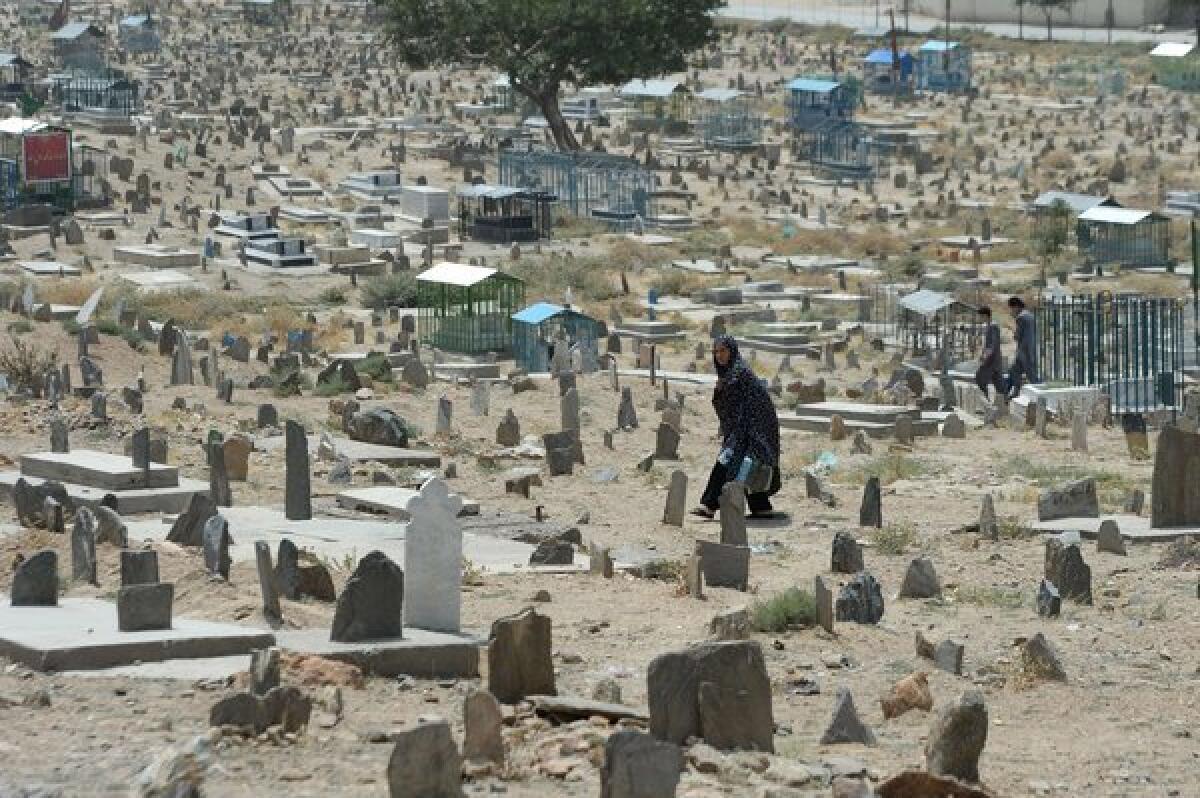Trump’s brand of war is killing more civilians than before

- Share via
WASHINGTON — The United Nations mission in Afghanistan reported recently that U.S. airstrikes and Afghan security forces killed more civilians in the first half of 2019 than the Taliban did.
The mission says “pro-government forces” killed 717 civilians while “anti-government forces” killed 531, and 118 deaths could not be attributed.
U.S. officials dispute the numbers. But if the U.N. is right, Afghans face greater danger of death from their government and its allies than from the Taliban, even counting a recent series of grisly car bombings in Kabul.
In Syria and Iraq, the U.S.-led coalition estimates that its airstrikes and artillery killed 1,321 noncombatants in the war against Islamic State since U.S. forces intervened in 2014 — but Airwars, an independent monitoring group, says at least 8,106 were killed.
In Yemen, where Saudi Arabia’s military is using U.S. intelligence to bomb Iran-backed Houthi insurgents with U.S.-supplied munitions, the U.N. says almost 20,000 civilians have been killed. Last week, a U.N. panel accused both sides of war crimes and warned that the United States may be complicit.
The Trump administration has also escalated the U.S. war against Shabab militants in Somalia, launching 123 airstrikes since early 2017. That’s four times as many as the Obama administration conducted over eight years. The Pentagon has acknowledged only two civilian deaths since 2017. Amnesty International says at least 14 civilians were killed, but on-the-ground reporting is almost impossible.
What’s the common thread? In all these conflicts, the Trump administration is trying to minimize the number of American troops on the ground by disengaging, fighting through proxies or limiting U.S. involvement to airstrikes and special operations.
But that hasn’t reduced the civilian casualties caused by U.S. and allied forces. It has made the problem worse.
It’s tempting to ascribe the change to the tone set by President Trump, who once proposed killing militants’ family members and boasted: “We are not nation-building again. We are killing terrorists.”
U.S. forces haven’t relaxed their prohibitions against targeting civilians. They insist they still take pains to avoid harming innocents.
Instead, most of the increase in civilian casualties has stemmed from a sharp increase in U.S. and allied airstrikes. The Pentagon says its forces in Afghanistan conducted 1,302 airstrikes in the first seven months of this year; that’s more than any full year since 2013.
U.S. and allied forces also relied largely on airstrikes to help retake two urban centers held by Islamic State in 2017: Raqqa in Syria and Mosul in Iraq. Thousands of civilians were caught in the crossfire, or blocked by the militants from fleeing.
“It’s not so much that the gloves are off or that they don’t care about civilians,” Daniel Mahanty, a former State Department official at the Washington-based nonprofit Center for Civilians in Conflict, told me. “It’s that they want to execute these operations in a way that focuses on speed, agility and overwhelming force.”
When the core U.S. strategy in Afghanistan or Iraq was “counterinsurgency,” winning the hearts and minds of civilians was an essential military goal. It’s no longer central.
Local militias and special operations units, some of them directed by the CIA, are partly to blame for the increase in civilian casualties.
One such unit, the Khost Protection Force in eastern Afghanistan, has been accused of a series of abusive actions. On Aug. 11, according to Afghan reports, the force captured and executed 11 unarmed civilians, including several students. Last week, Afghan President Ashraf Ghani fired his national intelligence chief, who helped direct the units.
Saudi Arabia’s war against the Houthis in Yemen has produced the most egregious casualties, with airstrikes hitting hospitals, schools and other civilian targets. The Trump administration is providing the Saudis with intelligence, tactical advice and weaponry — including help in targeting airstrikes.
U.S. military officials have jawboned the Saudis since the war began in 2015 to avoid civilian targets, arguing that harming civilians is counterproductive as well as immoral.
“It is a catastrophe,” then-Secretary of Defense James N. Mattis told a Senate committee last year. He said U.S. advisors were trying to change the Saudi military’s “culture.”
The effort has had no visible effect. Last week, a Saudi airstrike struck a detention camp run by the Houthis inside a university south of Sana, the capital, killing at least 100 people.
After 18 years of grinding wars on distant battlefields, Americans are understandably eager to bring the troops home.
But even if most are pulled out, the Trump administration plans to stay involved in these conflicts — through airstrikes, special operations, intelligence sharing and other aid to “partner forces.” Paradoxical as it may seem, civilian casualties may continue to increase.
We will be tempted to declare that our wars are over. They won’t be.
More to Read
Get the L.A. Times Politics newsletter
Deeply reported insights into legislation, politics and policy from Sacramento, Washington and beyond. In your inbox twice per week.
You may occasionally receive promotional content from the Los Angeles Times.










